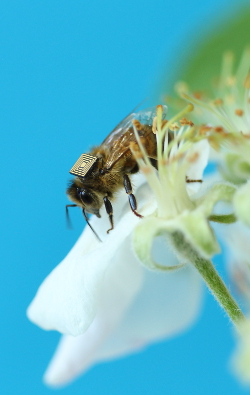Bees with backpacks swarm for science
 A new project will see thousands of bees decked-out in the scientific accessory of the summer - a 2.5mm wide sensor strapped to their backs to monitor the insects and their environment.
A new project will see thousands of bees decked-out in the scientific accessory of the summer - a 2.5mm wide sensor strapped to their backs to monitor the insects and their environment.
The research project is aimed at improving honey bee pollination on farms, as well as finding key drivers for a condition which has ravaged honey bee populations worldwide.
Around 5,000 sensors, each measuring 2.5mm x 2.5 mm, are being fitted to bees in Hobart before they are put back into the wild. The study marks largest number of insects ever used for environmental monitoring.
“Around one third of the food we eat relies on pollination,” CSIRO science leader Dr Paulo de Souza, who is heading the swarm sensing project, said.
“But honey bee populations around the world are crashing because of the dreaded Varroa mite and Colony Collapse Disorder. Thankfully, Australia is currently free from both of those threats.”
Another key research goal is to assess the impacts of agricultural pesticides on honey bees, by monitoring insects feeding at sites with known amounts of common chemicals.
“This should help us understand optimal productivity conditions as well as further our knowledge of the cause of colony collapse disorder,” Dr de Souza said.
The bees are outfitted with tiny radio frequency identification (RFID) tags, which are registered when bees pass mounted sensors – the system is just like the electronic tags used on toll-roads around the world.
The tags are attached while the bees have been sedated, and do not appear to injure them or hinder their activities in any way.
Researchers can use signals from the 5,000 sensors to build a three-dimensional model to visualise how the insects move throughout the landscape.
“Bees are social insects that return to the same point and operate on a very predictable schedule,” Dr de Souza said.
“Any change in their behaviour indicates a change in their environment. If we can model their movements, we'll be able to recognise very quickly when their activity shows variation and identify the cause.
“This will help us understand how to maximise their productivity as well as monitor for any biosecurity risks.”







 Print
Print